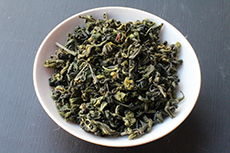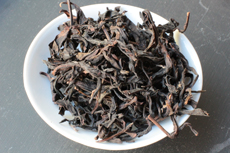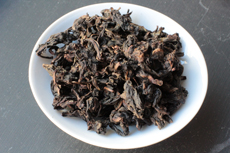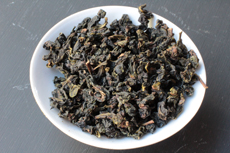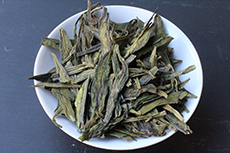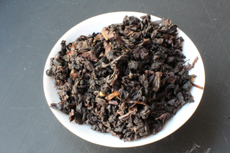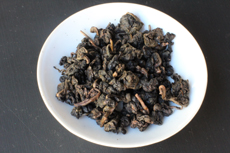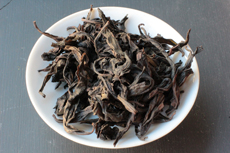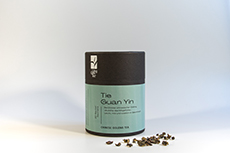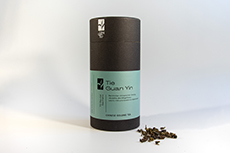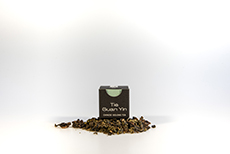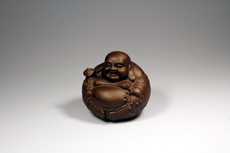.
Search results
Results 1 till 14 of a total of 14 (1 pages).
-
Fo Shou, Qi Lan, Ban Tian Yao, Wu Yi Zhong, Ai Jiao Wu LongJin Guan Yin, Hu
-
On the Art of Enjoying the Tea
-
Fo Xiang Bai Cha
Fo Xiang, Buddha Scent, is a very high quality tea produced in the form of Gunpowder or Chinese Zhu Cha, pearl tea. Just like An Ji Bai Cha it is produced with the leaves of the white leaved tea plant. A really beautiful example for the influence of the tea's form on its taste. Plucked by hand and produced by machine, however artisanally.The producer, who is known in his town as a tea freak, crazy for tea, owns vast tea gardens in the hills around Xinchang and produces a diversity of teas from diverse varietals in good quality.The tea is called Bai Cha, white tea, because the leaves are of a pale green, almost white, when they are plucked, as this tea plant has very little chlorophyll. However, it is produced in the manner of green tea. These tea plants with the whitish leaves had already been described during the Song-dynasty (960-1279), and were ever since thought to be a myth. At the end of the 20th century, however, a wild tea tree of this kind was (re-?)discovered. Teas from this tea varietal are very smooth and incredibly sweet in aroma. Because of the high degree of a certain amino acid in the tea plant these teas have a pronounced umami-taste. -
Lao Guan Yin
Laoguanyin translates as old Tieguanyin and in this case it means that the Teaguanyin has been produced as it was in the old times, before the leaves were shaped into lumps. This tea was produced at Mount Bijiashan, in the south west of the City Anxi.This tea has been produced traditionally, and contrary to modern Tieguanyin it has been wilted for a longer period, oxidised at room temperature, and the red rims of the leaves that result from the oxidation have not been removed. Then the tea was formed in a slightly twisted leaf and medium roasted - the appearance reminds of Wuyi Rock Tea, which is why it is also called Guan Yin Pao in reference to Dahongpao.The varietal Tieguanyin is named after Guanyin (in India: Avalokiteshvara), hence in the west this tea is sometimes also called Iron Buddha of compassion, as the name would translate. -
Chuan Tong Tie Guan Yin
Chuantong Tieguanyin means traditional Tieguanyin and is a genuine, original classic Tieguanyin, produced on Mount Bijiashan, in the south west of the city of Anxi.This tea has been produced traditionally, and contrary to modern Tieguanyin it has been wilted for a longer period, oxidised at room temperature, and the red rims of the leaves that result from the oxidation (Hongbian) have not been removed. Then the tea has been shaped into semi-lumps (Ban Qiu Xing) and moderately roasted. Replaces Tan Bei Tie Guan Yin.This tea is an attempt to approximate the Anxi Tieguanyin before they were made very green.The tea plant variety Tieguanyin is named after Guanyin (in India: Avalokiteshvara), hence in the west this tea is sometimes also called Iron Buddha of compassion, as the name would be translated. -
Hong Bian Tie Guan Yin
Hongbian Tieguanyin means Tieguanyin with a red ribbon. The name refers to the fact that the rim of the leaves that have been reddened through the oxidation have not been removed. Produced on the Montain Bijiashan, in the southwest of the city Anxi.This tea has been crafted in a traditional manner, contrary to modern Tieguanyin. This means that it has been wilted for a longer time, oxidised at room temperature and the oxidised rims of the leaves (Hongbian) have not been removed. Then the tea has been shaped into semi-lumps (Ban Qiu Xing) and only very slightly roasted.The varietal Tie Guan Yin is named after Guanyin (in India: Avalokiteshvara), hence in the west this tea is sometimes also called Iron Buddha of compassion, as the name would translate. -
Da Fo Long Jing
A wonderful Xinchang Long Jing, i.e. of non-original origin. Known as Dafo Longjing, named after the great Buddha temple in the city of Xinchang. This tea comes from a tea garden with many large rocks in it, which has a positive influence on the tea. Plucked by hand, artisanally produced, aided by machines. The producer, who is known in his town as a tea freak, crazy for tea, owns vast tea gardens in the hills around Xinchang and produces a diversity of teas from diverse varietals in good quality. -
Tie Guan Yin 2002
An Anxi Tieguanyin from 2002 of good quality, heavily post-roasted above charcoal and stored in China until 2013.The variety Tieguanyin is named after Guanyin (in India: Avalokiteshvara), and hence it is sometimes also called the tea of the Iron Buddha of Mercy. -
Fo Shou Buddhas Hand 1999
A Foshou (Buddhas Hand) tea of very good quality, produced as a ball-shaped Oolong tea, roasted and stocked, made from from the harvest of 1999. Stored in Taiwan until 2015. -
Wu Yi Fo Shou
A wonderful Wuyi Rock Tea made from the variety Foshou, which translates as Buddha's Hand. Foshou is difficult to work and is rarely grown in Wuyishan. Because of the mineral tastes and the heavy roasting this tea presents the taste so typical for Wuyi Yancha. -
Tie Guan Yin Sélection Grand Hotel KLEIN
Famous Chinese oolong tea, Buddha of Compassion. It is light, mild and sweet in taste. -
Tie Guan Yin Sélection Grand Hotel GROSS
Famous Chinese oolong tea, Buddha of Compassion. It is light, mild and sweet in taste. -
Tie Guan Yin Sélection Grand Hotel MINI
Famous Chinese oolong tea, Buddha of Compassion. It is light, mild and sweet in taste. -
Buddha
Happy Buddha made of clay, for Gong Fu Cha, with the meaning of attracting spiritual wealth and happiness.
.






